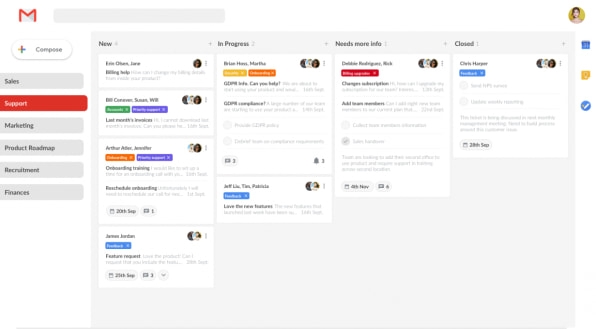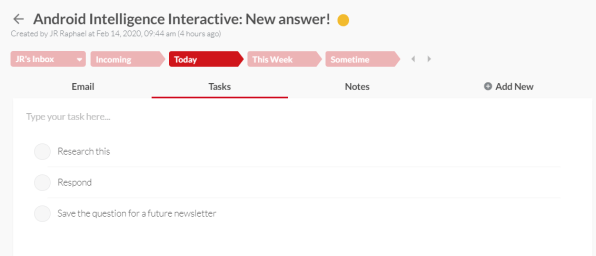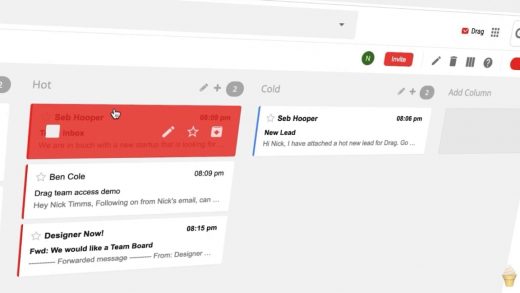This add-on transforms Gmail into an organizational powerhouse
When you stop and think about it, it’s strange that email tends to exist in a linear, strictly date-based arrangement. Your most recently received email isn’t usually the most important message in your inbox—and yet, when you open up Gmail, it’s almost always the first thing you see.
Nick Timms is convinced a better approach exists. Timms is the cofounder of a company called Drag, whose namesake app brings a card-based organizational system right into your regular Gmail inbox. The simplest way to think of it is as a mashup of Gmail and Trello—the best of both worlds, brought together into a single familiar environment.
“Gmail and single lists aren’t really conducive to mental health,” Timms says. “[We wanted to] bring another dimension to that so that people don’t just work through this single list of emails but have more structure to the way they plan their day.”
Timms and his team have been working on that concept for three years now, with their latest iteration rolling out just this month. I’ve been using it for a while, and I have to say: It feels less like a standalone app and more like an expansion of the existing Gmail experience. And once you grow accustomed to having it as part of your inbox, you may not want to go back.
Gmail, expanded
My discovery of Drag was serendipitous: I’ve long been a fan of Trello and the card-driven system it relies upon for organization. The basic idea is that you create a card for every piece of a project you’re working on. Then you use a series of columns to place those cards into a sensible structure. I rely on it to manage everything from story ideas to newsletter development and a variety of longer-term projects.
The more I’ve come to appreciate that highly deliberate, drag-and-drop-oriented method of organization, the more I’ve come to resent the chronological list Gmail forces upon me for my email. At a certain point every day, I end up looking at the messy rundown of messages demanding my attention and thinking: Sheesh—my tasks in Trello are so much easier to organize. I can drag and drop items into any order, attach notes and lists where I need them, and emphasize the stuff that matters most. Why can’t Gmail work the same way?
As I mulled over that notion for the millionth time recently, I happened to stumble onto Drag—which, as it turns out, is almost exactly what I’d been envisioning. At its core, Drag actually is Gmail. It’s an extension for Chrome that adds an extra switch to the standard Gmail website. When the switch is off, you see your regular Gmail inbox. Flip it on, and that same space is transformed into a Trello-like collection of cards spread across a series of customizable columns.

Following that Trello analogy, every message in your inbox—in the Primary tab, at least—exists as its own separate card in the Drag interface. New emails show up in the leftmost column, and you can drag messages (get it?) between the columns to categorize them and keep track of your priorities.
By default, Drag calls that first column “To Do” and then gives you a “Doing” column and a “Done” column alongside it. Personally, I’ve found it more useful to rename the first column to “Incoming” and then to have subsequent columns called “Today,” “This Week,” and “Sometime.”
That way, whenever I check my email, I can quickly triage whatever messages have come in and landed in that first column. If something requires no action from me, it gets archived. If it needs a relatively rapid response but I can’t get to it that very second, I drag it over to the “Today” column. And if something warrants a response but isn’t particularly pressing, I drag it over to either “This Week” or “Sometime,” depending on how high its priority is.
That leaves me with a clear visual breakdown of what I need to do before the day’s end—and what tasks I have to tackle later in the week and further down the road. It’s vaguely similar to my standard inbox strategy of snoozing messages and setting them to return at a time when I’ll be able to handle them, only here, I don’t have to decide on an exact time right away—and I can easily see what’s pending at a glance and shift items around as needed.
True to the Trello form, Drag even lets you add private notes, custom tags, and due dates to emails. It can sync with your Google Calendar and automatically add any items with due dates onto your agenda. It empowers you to attach task lists onto emails too—or to create standalone tasks that exist as their own cards alongside your messages. And it adds several other organizational extras into the mix, such as customizable systems for tags and color coding. Those work harmoniously with Gmail’s own labeling system and act as advanced ways to group related items together or add extra emphasis to certain cards.

In a way, the idea behind Drag is obvious. “Kanban, the Trello-style layout, has disrupted lots of different verticals,” Timms says. “But we saw that no one’s really successfully done it in the place that teams and individuals and people throughout the world really spend their time, which is email.”
And that leads directly into Drag’s ultimate ambition—the arena upon which the future of its business depends.
The bigger picture
While Drag started out with a focus on individual users—and still offers plenty of value on that front—the company’s primary business model has now evolved to focus mostly on teams. Timms and his colleagues want Drag to become the end-all space for an organization’s project management and communication, thus effectively eliminating the need for the very product that inspired them.
With Trello, Timms says, emails forwarded into the system are invariably converted into native Trello tasks instead of remaining in email form. Drag, in contrast, leaves emails as emails while also allowing for the sorts of standalone tasks Trello provides. And that, he believes, could allow two systems to be combined into one and a company’s toolset to be simplified considerably.
“We are bringing that true collaboration experience right into Gmail,” Timms says.
To that end, Drag’s team features allow you to create secondary boards that still live inside of Gmail but are shared with multiple team members. In that environment, the notes and tasks become collaborative surfaces—so messages coming into a customer support address, for instance, could be viewed and handled by multiple people without any forwarding or extra effort. And a company’s help desk could live alongside product road maps and project planning, all within the single familiar framework of the Gmail inbox.
If the service has one Achilles’ heel for the moment, it’s that it’s very much a desktop-centric experience. The company expects to launch an add-on for Gmail any day now that’ll let you perform basic Drag tasks from the regular Gmail mobile app—essentially just assigning emails to different Drag columns—but it doesn’t expect to have full-fledged standalone apps for iOS and Android ready until the spring.
As for pricing, Drag costs $99 a month for teams with five or more users. Companies with fewer than five employees can contact Drag to get a rate of $12 per user per month (or $9 per user per month, if you pay for a full year at once). Individual users can either opt to pay that same small-team rate or just stick with Drag’s single-user plan, which allows you to manage emails within a single board for free—though without extras such as standalone task cards and collaboration-oriented features.
Last but certainly not least, on the subject of privacy: Drag relies on Google’s official Gmail API to interact with your inbox. Timms says the extension has had to undergo extensive Google security audits to confirm its compliance with all of Google’s standards.
As the service’s privacy policy explains, that means the app is able to see only your email address and email metadata—which includes labels and headers but not message bodies—and it can also access individual email statuses indicating whether a specific message is read or unread, starred or unstarred, and so on. The service relies on subscriptions for its revenue, Timms assures me, and doesn’t do any sort of selling or advertising with the limited amount of user data it has.
All in all, Drag certainly seems to be checking off the right boxes. It’s an email enhancement worth exploring—and one that might just make your current one-dimensional inbox feel like a thing of the past.
For even more Google-centric productivity knowledge, check out my Android Intelligence newsletter.
(14)



